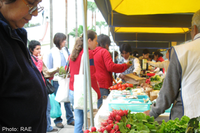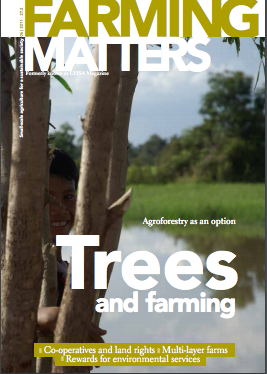Whether as a result of rising food prices, or simply because the world’s population is expected to continue growing, many projects and programmes are specifically focusing on food security and on the need to produce more food. Yet quantities are not all that matter. Are we paying enough attention to the quality of the food being produced? Our partners describe how this issue is being addressed in Peru, India and China.
Teresa Gianella: “More than yields and profits”

Fortunately, there are several local governmental programmes, in Peru and other parts of Latin America, that pay attention to the production and consumption of vegetables, or to the inclusion of nutrition courses in schools and in women’s organisations. Many follow the pioneering methods and approaches tried by NGOs with small groups, up-scaling them in terms of coverage and results. Yet, the Peruvian government has just signed a decree that allows the entering of GMOs seeds and the technology to support it, and this is making people wonder if there is a real interest in the quality of the food that we all eat.
GMOs can help increase the overall yields of some crops, but do not necessarily contribute to a diverse diet at a local or national level. “What I find scary is that no government official has mentioned the important link between production and consumption”. These are issues which, fortunately, are now receiving more attention.
T.M. Radha: “Less pulses; wrong ways”
For centuries, nutrition in rural India has meant a mix of cereals and pulses. Requiring very little water, pulses are ideally suitable for rainfed areas. But a sluggish growth in production has not been able to keep pace with the growth in population. While the demand for pulses kept increasing, supplies have been inadequate, leading to high price rises: at one time the price of pulses was higher than the price of meat. Not surprisingly, they are now rarely found in the diet of many rural people.
According to T.M. Radha, at the AME Foundation, this is the result of many factors. For decades, a combination of Green Revolution technologies and government policies has helped replace nutritious crops with those which can be easily sold in the market, such as rice or wheat. Research and extension programmes have focused primarily on these two crops. And the Public Distribution System (PDS), one of the world’s biggest government programmes for addressing food insecurity, has for years only focused on supplying cereals, and neglected the need of the poor for protein supplements.
So, chronic food insecurity and malnutrition persist. “The authorities’ interest in increasing production has led them to forget consumption”. Even more striking is the government’s support for research on “golden rice” and GM potato.
India is known for its traditional, low cost, self reliant food systems like the “Barahanaaja” in the north (which includes 12 different crops in the cropping system) and the “Satyam Pantalu” (a millet-based cropping system) in the south, so why not pay more attention to these? Nurtured by local communities and promoted by some NGOs, these two examples show that India does not need such expensive “research solutions” to its food and nutrition problems.
Ren Jian: “Concern about food production”
People in China are starting to worry more about food safety. Recently, there was a large controversy about the addition of chemicals to livestock feed. Since the late 1980s, clenbuterol, a drug used to treat breathing disorders, was added to pig feed in order to accelerate growth and increase the proportion of lean meat. Yet this chemical can affect the health of people who eat pork and its use was banned in 2002. When it was reported that the chemical was still being illegally used by the country’s largest meat producer, it sparked a nationwide campaign.
According to Ren Jian, editor of LEISA China, the Chinese government seems more concerned about GMOs. China has generally been more cautious about GMOs than western countries. Some envisage that the government will enact stricter laws concerning GMO import and export, research and development and production. Part of these plans is a new “grain security law” that should encourage local governments to produce more grain in accordance with regulatory guidelines.
However, “any new regulations are unlikely to have much impact on stemming the tide of GMO propagation”. The Ministry of Agriculture did approve the use of GM strains of rice and corn last year, setting the stage for the widespread cultivation and distribution of these strains.
Many groups are concerned that existing and planned regulations to restrict the use of GMOs will not be enforced. Greenpeace has reported that illegal sales of GMOs are already taking place. Despite China’s apparent careful approach to GMOs, it seems as if the concern about the production of what many call “Frankenfoods” does not automatically translate into successful GMO regulations.

